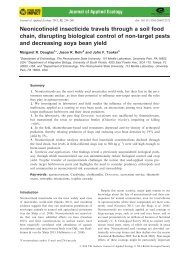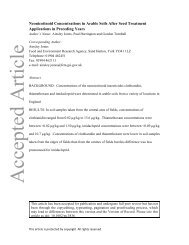g62-encyclopaedia-of-pests-and-natural-enemies-in-field-crops
g62-encyclopaedia-of-pests-and-natural-enemies-in-field-crops
g62-encyclopaedia-of-pests-and-natural-enemies-in-field-crops
- No tags were found...
Create successful ePaper yourself
Turn your PDF publications into a flip-book with our unique Google optimized e-Paper software.
Pest thresholds: quick referencePest thresholds: quick referenceOilseed rapeField beansCabbage seedweevil(p. 19)Cabbage stemflea beetle(p. 21)Weevils per plant dur<strong>in</strong>g flower<strong>in</strong>g:– Northern UK: 0.5– Elsewhere: 1Adult feed<strong>in</strong>g thresholds:– >25% leaf area eaten at the cotyledon–2 leaf stage– >50% leaf area eaten at the 3–4 leaf stage– The crop is grow<strong>in</strong>g more slowly than it is be<strong>in</strong>gconsumedBruchid beetle(p. 17)Pea <strong>and</strong> beanweevil(p. 25)Black beanaphid(p. 45)Treatment should be applied when, dur<strong>in</strong>g flower<strong>in</strong>g:– Adults have been found <strong>in</strong> the crop– The temperature has reached 20°C on two consecutivedays– Beans have developed the first pods on the lowest trussesSpr<strong>in</strong>g <strong>field</strong> beans:– An average <strong>of</strong> 30 or more weevils on any one record<strong>in</strong>gdayPollen beetle(p. 27)Mealy cabbageaphid(p. 59)Leatherjackets(p. 99)Slugs(p. 163)Thresholds for control <strong>of</strong> larvae:Yellow water trap:– >35 beetles/trap caught <strong>in</strong> total between earlySeptember <strong>and</strong> the end <strong>of</strong> OctoberPlant dissection:– >2 larvae per plant– 50% <strong>of</strong> petioles damagedBeetles per plant at the green to yellow bud stage:– If there are fewer than 30 plants/m 2 : 25– If there are 30–50 plants/m 2 : 18– If there are 50–70 plants/m 2 : 11– If there are more than 70 plants/m 2 : 7% <strong>of</strong> plants <strong>in</strong>fested before petal fall:– W<strong>in</strong>ter oilseed rape: more than 13%– Spr<strong>in</strong>g oilseed rape: more than 4%Prior to cultivation:– More than 50 leatherjackets per m 2– More than 5 leatherjackets <strong>in</strong> 12 pipes– More than 5 leatherjackets per metre <strong>of</strong> rowSlugs per refuge trap, prior to cultivation:– In cereal <strong>crops</strong>: 4– In cereal stubble: 1Slugs (p. 163)PeasPea <strong>and</strong> beanweevil(p. 25)Pea aphid(p. 61)Pea midge(p. 105)Pea moth(p. 141)Early flower<strong>in</strong>g until pod formation:– 10% <strong>of</strong> plants <strong>in</strong>fested: Immediate treatment is justified– 5% <strong>of</strong> plants <strong>in</strong>fested: Treatment can help prevent virus<strong>in</strong>fection1 slug per refuge trap, prior to cultivationSpr<strong>in</strong>g-sown peas:– An average <strong>of</strong> 30 or more weevils on any one record<strong>in</strong>gday% plants <strong>in</strong>fested, May to July:– Comb<strong>in</strong><strong>in</strong>g peas: 20% or more– V<strong>in</strong><strong>in</strong>g peas: 15% or moreIf more than 500 midges are caught on one trap (placedby the third week <strong>of</strong> May), susceptible pea <strong>crops</strong> <strong>in</strong> thenear vic<strong>in</strong>ity should be exam<strong>in</strong>edDry harvested peas for human consumption:– 10 or more moths caught <strong>in</strong> traps (placed by the middle<strong>of</strong> May <strong>and</strong> exam<strong>in</strong>ed at two-day <strong>in</strong>tervals) on twoconsecutive occasionsV<strong>in</strong><strong>in</strong>g peas:Traps are just used to determ<strong>in</strong>e if moths are present.Growers should be guided by the factory <strong>field</strong>sman aseven very small <strong>in</strong>festations can lead to rejectionV<strong>in</strong><strong>in</strong>g peas:– Cumulative catch exceeds 50 moths by the first podstage (GS204)Silver Y moth(p. 143)Slugs (p. 163)1 slug per refuge trap, prior to cultivation13Encyclopaedia <strong>of</strong> <strong>pests</strong> <strong>and</strong> <strong>natural</strong> <strong>enemies</strong> <strong>in</strong> <strong>field</strong> <strong>crops</strong>Encyclopaedia <strong>of</strong> <strong>pests</strong> <strong>and</strong> <strong>natural</strong> <strong>enemies</strong> <strong>in</strong> <strong>field</strong> <strong>crops</strong>14




